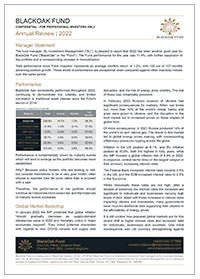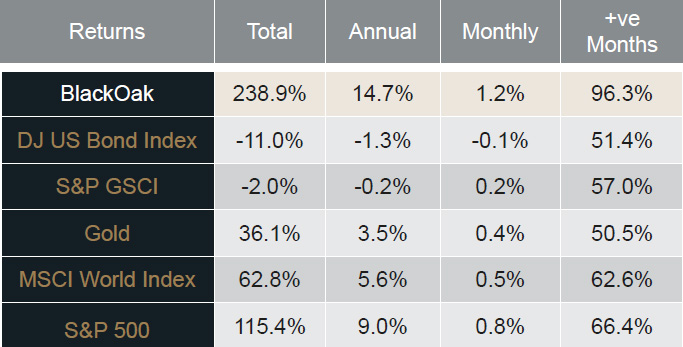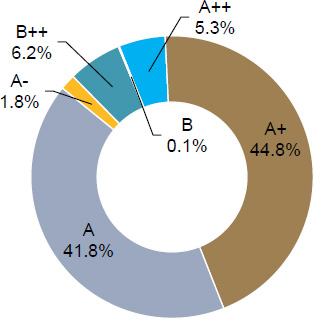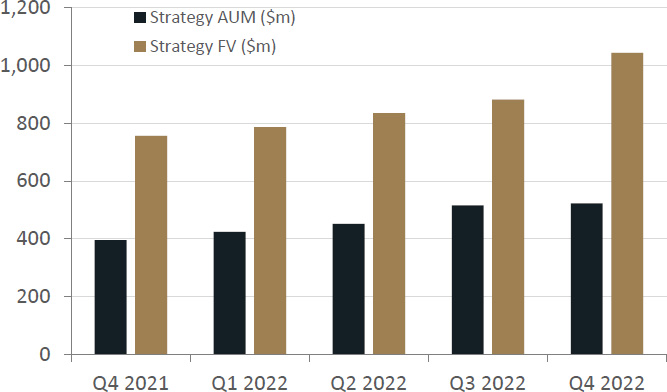CONFIDENTIAL – FOR PROFESSIONAL INVESTORS ONLY
Manager Statement
The fund manager, SL Investment Management (“SL”), is pleased to report that 2023 has been another good year for BlackOak Fund (“BlackOak” or the “Fund”).
As the fund approaches its 10-year anniversary, annualised returns to the end of 2023 have been 14.2%, outperforming most major indices. This has been achieved over a period of sustained global turmoil, transgressing events such as COVID-19, the 2016 US Presidential Elections and Brexit.
Total performance since Fund inception represents an average monthly return of 1.2%, with 115 out of 119 months achieving positive returns. These levels of performance are exceptional when compared against other mainstay indices over the same period.
Performance
BlackOak has consistently performed throughout 2023, continuing to demonstrate low volatility and limited correlation to traditional asset classes since the Fund’s launch in 2014:
Returns from 31 January 2014 to December 2023: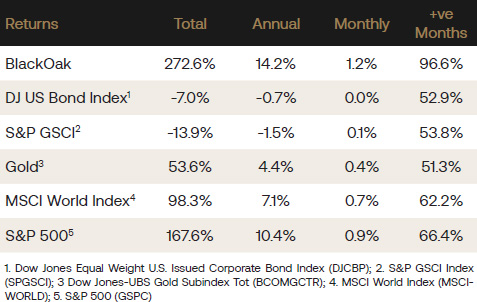
Performance is fundamentally driven by maturity events which will tend to emerge as the portfolio becomes more established. Therefore, as the portfolio becomes more seasoned and further maturities emerge, this should drive future performance and growth.
Global Market Backdrop
In the wake of challenges like the COVID-19 pandemic and the Russian invasion of Ukraine, concerns about higher inflation and a potential economic downturn loomed large. However, contrary to initial fears, inflation rates have decreased more rapidly than anticipated, and employment levels and economic activity have shown resilience, alleviating some of these concerns.
In January 2023, the IMF projected a global economic growth rate of 2.9% for the year, slightly surpassed by the actual growth rate of 3.1%. While this growth is positive, it remains below the average of 3.8% observed between 2000 and 2019. Notably, European advanced economies posted disappointing growth rates, with the EU and UK achieving only 0.5% growth. In contrast, the US and China performed better, with growth rates of 2.5% and 5.2% respectively.
Inflationary pressures persisted due to the resolution of supply chain disruptions stemming from COVID-19 and a surge in global energy prices. While Western countries experienced double-digit inflation, China and Japan fared relatively better with inflation rates of 2.1% and 4.3%, respectively.
To combat inflation, several countries implemented significant interest rate hikes, which have begun to show positive effects. Annual inflation averaged 6.8% in 2023, down from 8.8% in 2022.
Despite initial concerns, equities performed well throughout 2023, with the MSCI world index increasing by 21.8%, driven by strong performances in the technology, aerospace, and defence sectors. However, the index failed to fully recover losses from 2022, ending 1.9% lower than its end 2021 value.
Corporate bonds experienced modest growth of 4.4% in 2023, yet the Dow Jones corporate bond index remained 16.6% lower than the end 2021, highlighting ongoing challenges in this sector.
Geopolitical tensions escalated further after the October 7th attack on Israel, potentially affecting global oil and gas production. While energy prices have not yet surged to levels seen during the Russian invasion of Ukraine, disruptions in trade routes, particularly through the Red Sea, have led to a doubling in global shipping costs from mid-December 2023 to January 2024.
Moreover, increasing trade barriers coupled with a trend towards inward-looking policies across various countries raise concerns about the future of global trade and economic cooperation.
With elections scheduled for roughly half of the world’s population in 2024, the spectre of protectionism looms large, particularly in the event of the election of candidates advocating such policies.
Life Settlement Market
The performance of a life settlement holding hinges primarily on mortality events within a portfolio, making them resilient to external economic fluctuations. Despite ongoing conflicts in regions like Ukraine and the Middle East, and resultant inflationary pressures, existing life settlement portfolios such as BlackOak have seen negligible impact.
However, it’s crucial to recognise that life settlements are ‘minimally correlated’ assets, meaning external events can influence the long-term supply and demand dynamics, affecting policy prices. Factors like prolonged low interest rates up until 2022 and the economic repercussions of the global pandemic have spurred increased demand for life settlements.
This surge in demand has been met with a growing supply of policies, driven by heightened awareness among US seniors and their need to supplement incomes.
The industry saw notable growth, with trading volumes reaching $4.5 billion in 2022, largely propelled by direct-to-consumer initiatives like extensive TV advertising. While trading volumes in tertiary markets – where existing portfolio holders trade with one another – are less publicised, anecdotal evidence suggests higher activity compared to the secondary market – where policies are acquired from original policyholders.
At the onset of 2023, substantial capital remained undeployed, fostering intense competition for policies across all sectors. However, as interest rates rose throughout the year, demand softened, presenting favourable opportunities for buyers such as BlackOak.
Market prices for policies catering to older individuals with shorter life expectancies have seen modest shifts, while policies covering younger lives with longer life expectancies have seen more significant adjustments, potentially offering increased value for BlackOak as we progress through 2024.
In November, US insurance consultants Conning released their 18th annual report, projecting steady growth in the life settlement industry over the next decade. They estimate a substantial net market potential of up to $189 billion annually by 2032, underscoring the opportunity for further growth with extended public awareness.
Looking ahead to 2024, economic and geopolitical uncertainties persist, fuelled by conflicts in key regions and escalating tensions between major powers like the US and China.
The year will also witness numerous elections globally, with the potential to introduce volatility in traditional markets. Amidst these uncertainties, the relative attractiveness of life settlement investments is expected to rise, particularly with anticipated decreases in US interest rates as inflationary pressures ease, further stimulating demand in the market.
Turbulence Ahead: Global Uncertainties
The United States presidential election is a pivotal event not only for American citizens but also for global economies. The transition of power and the policies implemented by the incoming administration can significantly impact investor sentiment worldwide. As the US gears up for another election cycle, businesses, investors, and policymakers are bracing for potential disruption.
One of the primary drivers of economic volatility surrounding the US election is political uncertainty. Uncertainty regarding future policies, regulations, and fiscal measures can lead to cautious behaviour among businesses and consumers alike. This hesitancy often translates into reduced investment, slower economic growth, and heightened market fluctuations.
Financial markets are particularly sensitive to political developments, with investors closely monitoring election-related news and outcomes. The uncertainty surrounding the election often leads to increased volatility in global stock markets, currency exchange rates, and commodity prices.
The outcome of the US election can have profound implications for economic policy, including taxation, fiscal spending, trade agreements, and regulatory frameworks. Different political parties often adopt divergent economic ideologies, which can result in significant policy shifts depending on the party in power.
The US plays a central role in the global economy, with its trade policies and diplomatic relations exerting far-reaching effects. Changes in leadership can lead to shifts in trade negotiations, tariffs, and international alliances, impacting supply chains, export-import dynamics, and market access for businesses worldwide. Consequently, fluctuations in US trade policy can contribute to economic uncertainty and market volatility on a global scale.
Meanwhile in Europe, there are not only elections to the European Parliament in June, but also in many individual countries (Portugal parliamentary elections in March, Iceland presidential elections in June, Austrian national council elections around September and, most significantly UK parliamentary elections likely in late 2024).
In the event the winning political parties in these elections (either far right or far left) isolate the economic agenda and focus only on populist policies, this could have a further negative impact on global trade, adversely impact export-oriented economies and lead to increased volatility in financial markets. While the most serious economic risk in Europe in 2022/2023 was the supply crisis in energy, in 2024 it could be political and geopolitical uncertainties.
Uncertainty is detrimental not only to investment and growth in the short term, but also in the long term. This uncertainty could be heightened in case of a wider Middle East conflict and further disruption in the trade routes in the Red Sea. Over 12% of the global trade passes through the Red Sea and any significant re-routing of this trade could lead to a further increase in shipping costs and pose a challenge to European and global economic activity alike.
This activity could also see a challenge from the slowing growth in China. Renowned for its economic prowess, the country is encountering a period of moderated growth. As the world’s second-largest economy, it has experienced a slowdown in recent years, prompting attention domestically and internationally. This slowdown has global implications, influencing trade, investment flows, and commodity markets, and should be an important consideration for investors in 2024.
BlackOak Fund Portfolio Development
Throughout 2023 trading in the life settlement market remained strong; although competition for policies eased as the year progressed and prices in some sectors of the market, where BlackOak has historically avoided, softened. These sectors may now provide enhanced investment value for BlackOak in 2024.
For BlackOak, the focus for 2023 has been to maintain investment in line with new capital raised, whilst remaining disciplined on the selective investment strategy that has been the key driver of performance since launch.
We are pleased to report that this goal has been largely achieved through initiatives to consolidate relationships with key sourcing partners in the US; particularly those looking to drive direct-to-consumer initiatives where we perceive better value and diversification opportunities to continue to prevail.
During 2023 SL Investment Management has successfully deployed over $597m (face value) into new life settlement investments, with an average purchase IRR of 12.2%, well above the minimum purchase IRR allowable of 9.0%.
New life settlement investments have continued to support portfolio diversification, with the number of insurance companies represented within the portfolio maintained at around 90 over the year.
The concentration of the largest insurance company, John Hancock Life remains below 10%. This has been achieved whilst maintaining the proportion of the portfolio with an AM Best rating of A or higher at 92%, representing the superior financial strength of the underlying insurers, and their ability to fulfil their payment obligation upon maturity.
BlackOak – A.M. Best Financial Strength Ratings Dec 2023:

As per last year, the distribution of Primary Health Impairments (PHIs) for lives assured in the portfolio has been smoothed in 2023.
Exposure to cardiovascular conditions has been further reduced. It is important to maintain a good diversification of PHIs to smooth the impact of medical breakthroughs and their positive impact on population longevity.
Finally, the Period to Loss (PtL) for the portfolio has been improved in 2023. This is a measure of how long lives assured would need to live beyond their life expectancy for the policy purchase cost and premiums paid to exceed the death benefit. This has been increased from 251% to 268%, meaning that lives assured would on average have to live nearly 2.7 times their life expectancy for the portfolio to become loss making.
Strategic AUM Growth
BlackOak employs a sophisticated investment strategy, developed through SL’s 34-year experience of secondary insurance markets – having advised and managing assets in excess of $9.5bn.
This highly selective investment approach, where only a small proportion of policies reviewed are acquired by clients, is the result of the disciplined analytical approach adopted by the management team. Having analysed over 586,000* policies, SL is able to identify where the best investment opportunities are available for investors.

* Figure includes US life settlements and UK traded endowment policies
Actual to Expected analysis
The Actual to Expected analysis (A to E) shows the occurrence of actual mortality events within a life settlement portfolio, against statistically expected mortality events as inferred from the Life Expectancy (LE) reports at the point of purchase. A to E is a useful measure to track how reasonable underwriters’ assumptions are in assessing LEs of the lives insured.
It is also a useful indication of the manager’s ability to identify areas within the life settlement market where underwriters can be more conservative in their LE assessments (i.e. longer), and equally those areas where underwriters may be overly aggressive (i.e. shorter in their assessments).
A successful life settlement manager will focus their investment programme on acquiring policies where the underwriters tend to be consistently longer in their assessments, and avoid areas where underwriters are typically shorter.

The A to E for BlackOak indicates that the value of mortality events experienced by the fund to end 2023 has been 119% when compared to the value inferred from the original LE assessments. In other words, the value of maturity proceeds exceeds those projected by the original LE reports by 19%, resulting in a corresponding increase in performance since inception.
Outlook 2024
As we step into 2024, the world finds itself at a crossroads of hope and uncertainty. Despite significant progress in various domains, geopolitical tensions, economic disparities, and environmental challenges continue to shape the global landscape.
Geopolitical tensions persist, driven by competition between major powers, particularly the US, China, and Russia, over influence and resources. Various regions, from the Middle East to Eastern Europe and the Asia-Pacific, witness simmering conflicts and power struggles, posing risks to stability.
Many economies are on a path to recovery from the impacts of the COVID-19 pandemic. However, supply chain disruptions, inflationary pressures, and uneven vaccine distribution pose challenges.
Accelerated digitalisation continues to reshape industries, with advancements in artificial intelligence, blockchain, and other technologies driving innovation and disruption.
Despite challenges, international cooperation remains essential for addressing global crises, such as pandemics, and nuclear proliferation. Diplomatic initiatives aim to foster dialogue and consensus-building on critical issues, from nuclear disarmament to humanitarian crises.
2024 presents a complex global landscape characterised by both opportunities and risks. Navigating these challenges will require collaborative efforts, innovative solutions, and a steadfast commitment to building a more resilient and sustainable future for all.
As a consequence, whilst traditional capital markets may continue to experience volatile months ahead, we anticipate life settlement yields will continue to offer stable and attractive returns.
With risk-free rates expected to fall during the year, we anticipate increased interest from investors seeking minimally correlated alternatives such as life settlements.
Supply-side dynamics remain positive, and we expect secondary market supply to continue its upward trend as public awareness of the life settlement option grows; especially with direct-to-consumer initiatives gathering pace.

Disclaimer
This material is intended for “investment professionals” as defined in article 19 of the Financial Services and Markets Act 2000 (Financial Promotion) Order 2005 and must not be acted or relied upon by other persons.
The information and opinions published herein do not constitute an invitation or offer to buy or sell Life Settlements or other financial instruments, nor an invitation or offer to undertake other transactions. They are published purely for information purposes.
The information and opinions published herein constitute neither recommendations nor guidance for decisions concerning your investments and other matters, and do not have any advisory character whatsoever. Therefore, before making any investment or other decisions, you should seek the advice of a qualified specialist.
This material and the copyright in the content are owned by SL Investment Management Limited.




